 American Journal of Computational Mathematics, 2013, 3, 175-184 http://dx.doi.org/10.4236/ajcm.2013.33026 Published Online September 2013 (http://www.scirp.org/journal/ajcm) Numerical Solution of Nonlinear System of Partial Differential Equations by the Laplace Decomposition Method and the Pade Approximation Magdy Ahmed Mohamed1, Mohamed Shibl Torky2 1Faculty of Science, Suez Canal University, Ismailia, Egypt 2The High Institute of Administration and Computer, Port Said University, Port Said, Egypt Email: dr_magdy_ahmed53@yahoo.com, mohamedtorky@himc.psu.edu.eg Received March 7, 2013; revised April 28, 2013; accepted May 9, 2013 Copyright © 2013 Magdy Ahmed Mohamed, Mohamed Shibl Torky. This is an open access article distributed under the Creative Commons Attribution License, which permits unrestricted use, distribution, and reproduction in any medium, provided the original work is properly cited. ABSTRACT In this paper, Laplace decomposition method (LDM) and Pade approximant are employed to find approximate solutions for the Whitham-Broer-Kaup shallow water model, the coupled nonlinear reaction diffusion equations and the system of Hirota-Satsuma coupled KdV. In addition, the results obtained from Laplace decomposition method (LDM) and Pade approximant are compared with corresponding exact analytical solutions. Keywords: Nonlinear System of Partial Differential Equations; The Laplace Decomposition Method; The Pade Approximation; The Coupled System of the Approximate Equations for Long Water Waves; The Whitham Broer Kaup Shallow Water Model; The System of Hirota-Satsuma Coupled KdV 1. Introduction The Laplace decomposition method (LDM) is one of the efficient analytical techniques to solve linear and nonlin- ear equations [1-3]. LDM is free of any small or large parameters and has advantages over other approximation techniques like perturbation. Unlike other analytical tech- niques, LDM requires no discretization and linearization. Therefore, results obtained by LDM are more efficient and realistic. This method has been used to obtain ap- proximate solutions of a class of nonlinear ordinary and partial differential equations [1-4]. See for example, the Duffing equation [4] and the Klein-Gordon equation [3]. In this paper, the LDM is applied to, the Whitham-Broer- Kaup shallow water model [5] , , txxxx txxxxx uuuvu vvuuvv u xx (1) with exact solution are given in [5] as 2 1 22 2 2 22 2 1 ò ,2 tanh, ,2 2tanhò, uxtkkx t vxt k kk xt (2) and the coupled nonlinear reaction diffusion equations [6], 2 2 , , txx x txx x uku uvu vkv uvu (3) with exact solution are given in [6] as 2 22 4 ,21tanh , 2 44 ,2tanh 2 22 Bck uxtkct cx Bck Bck vxtkct cx kc , (4) and thesystem of Hirota-Satsuma coupled KdV [7]. 1333 2 3, 3, t xxx xxx t xxxx t xxxx uu uuvwwv vv uv ww uw , (5) with exact solution are given in [7] as 222 2222 0 2 1 1 01 1 ,22tanh , 2 44 ,tanh 3 3 ,tanh , uxtkkkx t kckkk vxtkx t c c wxtc ckxt , (6) C opyright © 2013 SciRes. AJCM 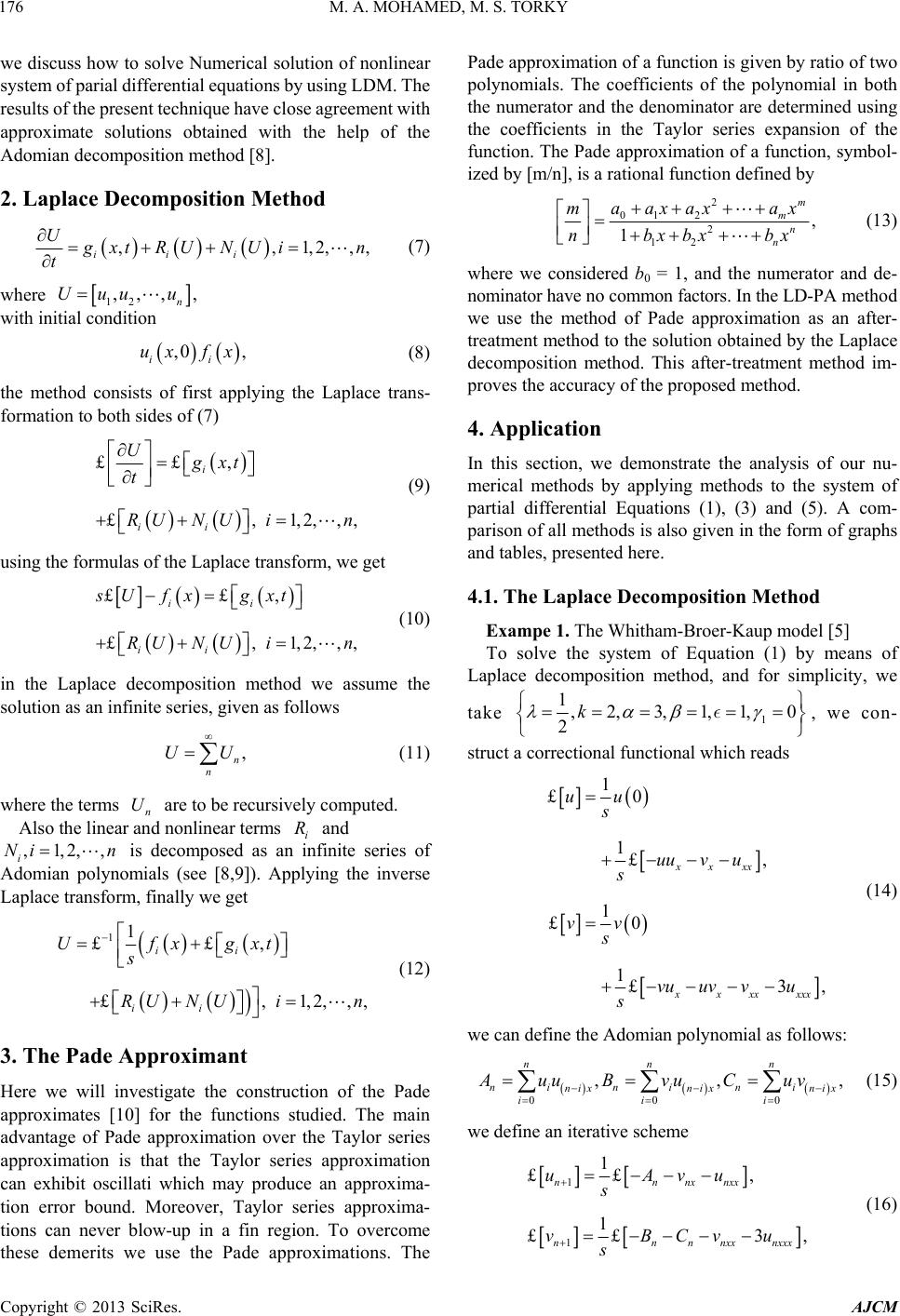 M. A. MOHAMED, M. S. TORKY 176 we discuss how to solve Numerical solution of nonlinear system of parial differential equations by using LDM. The results of the present technique have close agreement with approximate solutions obtained with the help of the Adomian decomposition method [8]. 2. Laplace Decomposition Method ,, iii U1,2,,, xtR UNUin t (7) where 12 ,,, , n Uuu u with initial condition ,0 , ii ux fx (8) the method consists of first applying the Laplace trans- formation to both sides of (7) ££, £,1, i ii Ugxt t RU NUin 2,,, (9) using the formulas of the Laplace transform, we get ££, £,1, ii ii sU fxgxt RU NUin 2,,, (10) in the Laplace decomposition method we assume the solution as an infinite series, given as follows , n n UU (11) where the terms are to be recursively computed. n Also the linear and nonlinear terms i and is decomposed as an infinite series of Adomian polynomials (see [8,9]). Applying the inverse Laplace transform, finally we get UR ,1,2,, i Ni n 11 ££, £, ii ii Ufxgxt s RU NUin 1,2,,, (12) 3. The Pade Approximant Here we will investigate the construction of the Pade approximates [10] for the functions studied. The main advantage of Pade approximation over the Taylor series approximation is that the Taylor series approximation can exhibit oscillati which may produce an approxima- tion error bound. Moreover, Taylor series approxima- tions can never blow-up in a fin region. To overcome these demerits we use the Pade approximations. The Pade approximation of a function is given by ratio of two polynomials. The coefficients of the polynomial in both the numerator and the denominator are determined using the coefficients in the Taylor series expansion of the function. The Pade approximation of a function, symbol- ized by [m/n], is a rational function defined by 2 01 2 2 12 , 1 m mn n aaxax ax m nbx bxbx (13) where we considered b0 = 1, and the numerator and de- nominator have no common factors. In the LD-PA method we use the method of Pade approximation as an after- treatment method to the solution obtained by the Laplace decomposition method. This after-treatment method im- proves the accuracy of the proposed method. 4. Application In this section, we demonstrate the analysis of our nu- merical methods by applying methods to the system of partial differential Equations (1), (3) and (5). A com- parison of all methods is also given in the form of graphs and tables, presented here. 4.1. The Laplace Decomposition Method Exampe 1. The Whitham-Broer-Kaup model [5] To solve the system of Equation (1) by means of Laplace decomposition method, and for simplicity, we take 1 1,2,3,1,1, 0 2k , we con- struct a correctional functional which reads 1 £0 1£, 1 £0 1£3 xxxx xxxxxxx uu s uuvu s vv s vu uv vu s , , (14) we can define the Adomian polynomial as follows: 000 ,, nnn ni ni ni nix nix nix iii AuuBvuCuv (15) we define an iterative scheme 1 1 1 ££ , 1 ££ 3 nn nxnxx nnn nxxnxxx uAvu s vBCvu s , (16) Copyright © 2013 SciRes. AJCM 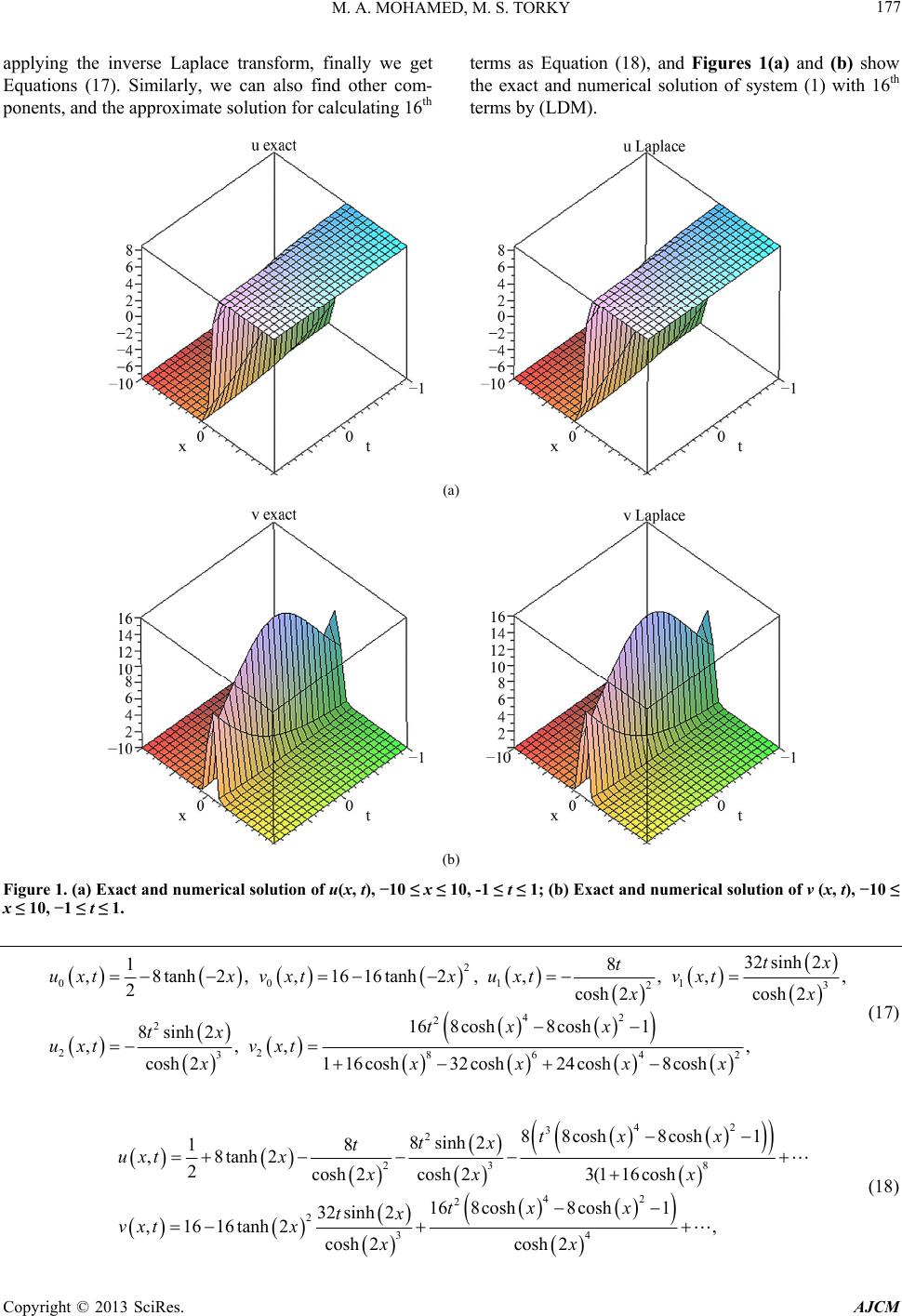 M. A. MOHAMED, M. S. TORKY Copyright © 2013 SciRes. AJCM 177 terms as Equation (18), and Figures 1(a) and (b) show the exact and numerical solution of system (1) with 16th terms by (LDM). applying the inverse Laplace transform, finally we get Equations (17). Similarly, we can also find other com- ponents, and the approximate solution for calculating 16th (a) (b) Figure 1. (a) Exact and numerical solution of u(x, t), −10 ≤ x ≤ 10, -1 ≤ t ≤ 1; (b) Exact and numerical solution of v (x, t), −10 ≤ x ≤ 10, −1 ≤ t ≤ 1. 2 00 11 23 42 2 2 22 38642 32 sinh2 18 ,8tanh2,,1616tanh2,,,, 2cosh 2cosh 2 16 8cosh8cosh1 8sinh2 ,,, , cosh2116 cosh32 cosh24 cosh8 cosh tx t uxtx vxtxuxtvxt xx tx x tx uxt vxt xxxxx , (17) 42 3 2 23 8 42 2 2 34 88cosh8cosh 1 8sinh2 18 ,8tanh2 2cosh2cosh23(116 cosh 16 8cosh8cosh1 32 sinh2 ,1616tanh2 , cosh 2cosh 2 tx x tx t uxtx xx x tx x tx vxtx xx (18) 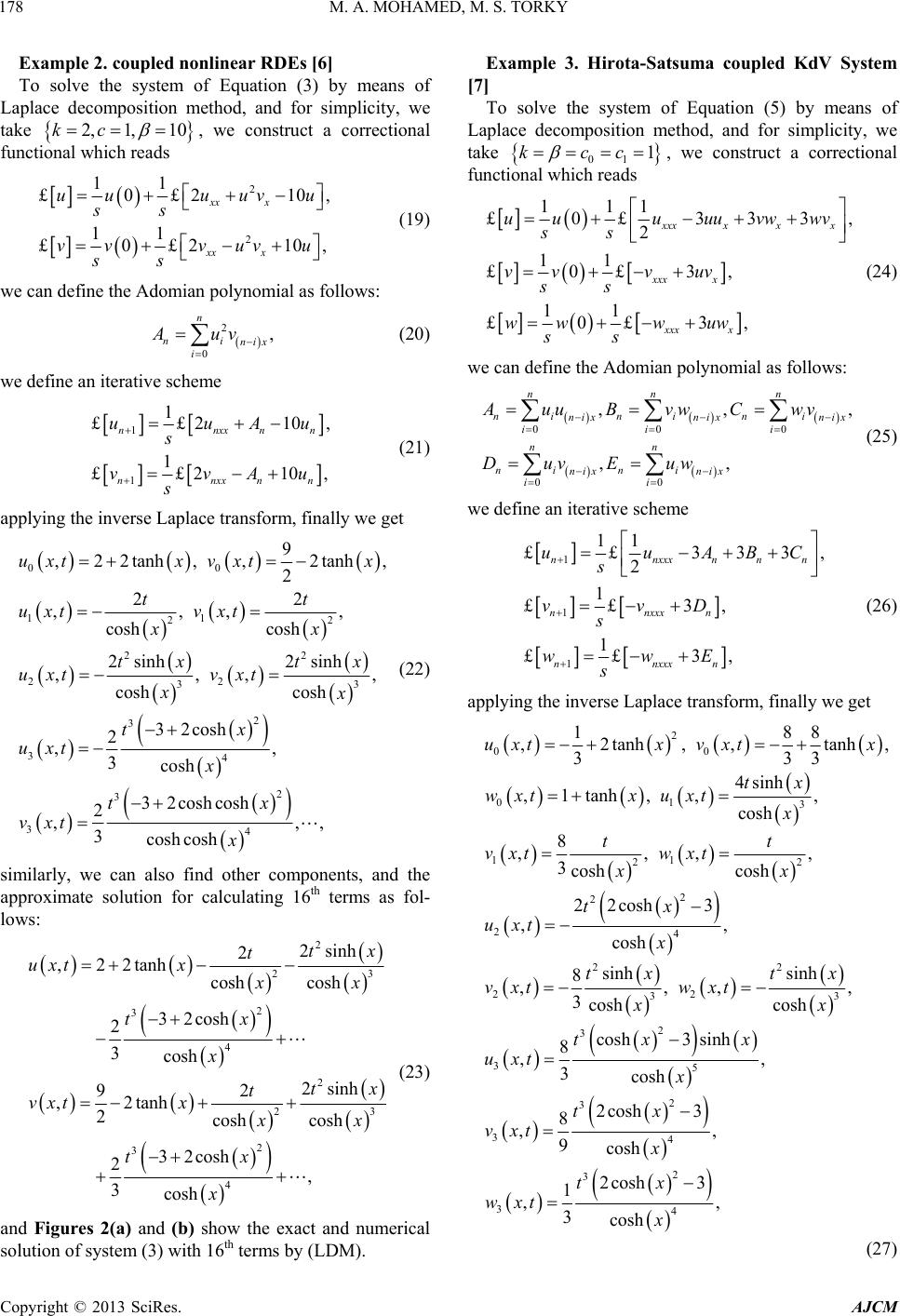 M. A. MOHAMED, M. S. TORKY 178 Example 2. coupled nonlinear RDEs [6] To solve the system of Equation (3) by means of Laplace decomposition method, and for simplicity, we take , we construct a correctional functional which reads 2, 1,10kc 2 2 11 £02 10 11 £02 10 £ ,£ xx x xx x uu uuvu ss vv vuvu ss , (19) we can define the Adomian polynomial as follows: 2 0 , n ni nix i Auv (20) we define an iterative scheme 1 1 1 ££2 10 1 ££2 10 nnxxn nnxxn uuA s vvA s , , n n u u (21) applying the inverse Laplace transform, finally we get 00 11 22 22 22 33 2 3 34 2 3 34 9 ,22tanh, ,2tanh 2 22 ,,, cosh cosh 2sinh2sinh ,,, cosh cosh 32cosh 2 ,, 3cosh 32cosh cosh 2 ,, 3cosh cosh uxtx vxtx tt uxt vxt xx tx tx uxt vxt x tx uxt x tx vxt x , , , , x (22) similarly, we can also find other components, and the approximate solution for calculating 16th terms as fol- lows: 2 23 2 3 4 2 23 2 3 4 2sinh 2 ,22tanh cosh cosh 32cosh 2 3cosh 2sinh 92 ,2tanh 2cosh cosh 32cosh 2, 3cosh tx t uxtxxx tx x tx t vxt x x tx x (23) and Figures 2(a) and (b) show the exact and numerical solution of system (3) with 16th terms by (LDM). Example 3. Hirota-Satsuma coupled KdV System [7] To solve the system of Equation (5) by means of Laplace decomposition method, and for simplicity, we take 01 1kcc , we construct a correctional functional which reads 111 £0 33£ £ £ 3, 2 11 £0 3, 11 £0 3, xxx xxx xxx x xxx x uuu uuvwwv ss vvvuv ss wwwuw ss (24) we can define the Adomian polynomial as follows: 00 0 00 ,, ,, nn n ninin i nix nix nix ii i nn ni ni nix nix ii AuuBvwCwv DuvE uw , (25) we define an iterative scheme 1 1 1 11 ££333 2 1 ££3, 1 ££3, nnxxx n nn nnxxxn nnxxxn uuAB s vvD s wwE s ,C (26) applying the inverse Laplace transform, finally we get 2 00 01 3 11 22 2 2 24 22 22 33 2 3 35 18 ,2 tanh,,tanh, 33 4sinh ,1tanh, ,, cosh 8 ,,,, 3cosh cosh 22cosh 3 ,, cosh sinh sinh 8 ,,, 3cosh cosh cosh3sinh 8 ,, 3cos h uxtx vxtx tx wxtx uxtx tt vxt wxt xx tx uxt x tx tx vxt wxt xx tx x uxt x 8 3 , 2 3 34 2 3 34 2cosh3 8 ,, 9cosh 2cosh 3 1 ,, 3cosh tx vxt x tx wxt x (27) Copyright © 2013 SciRes. AJCM 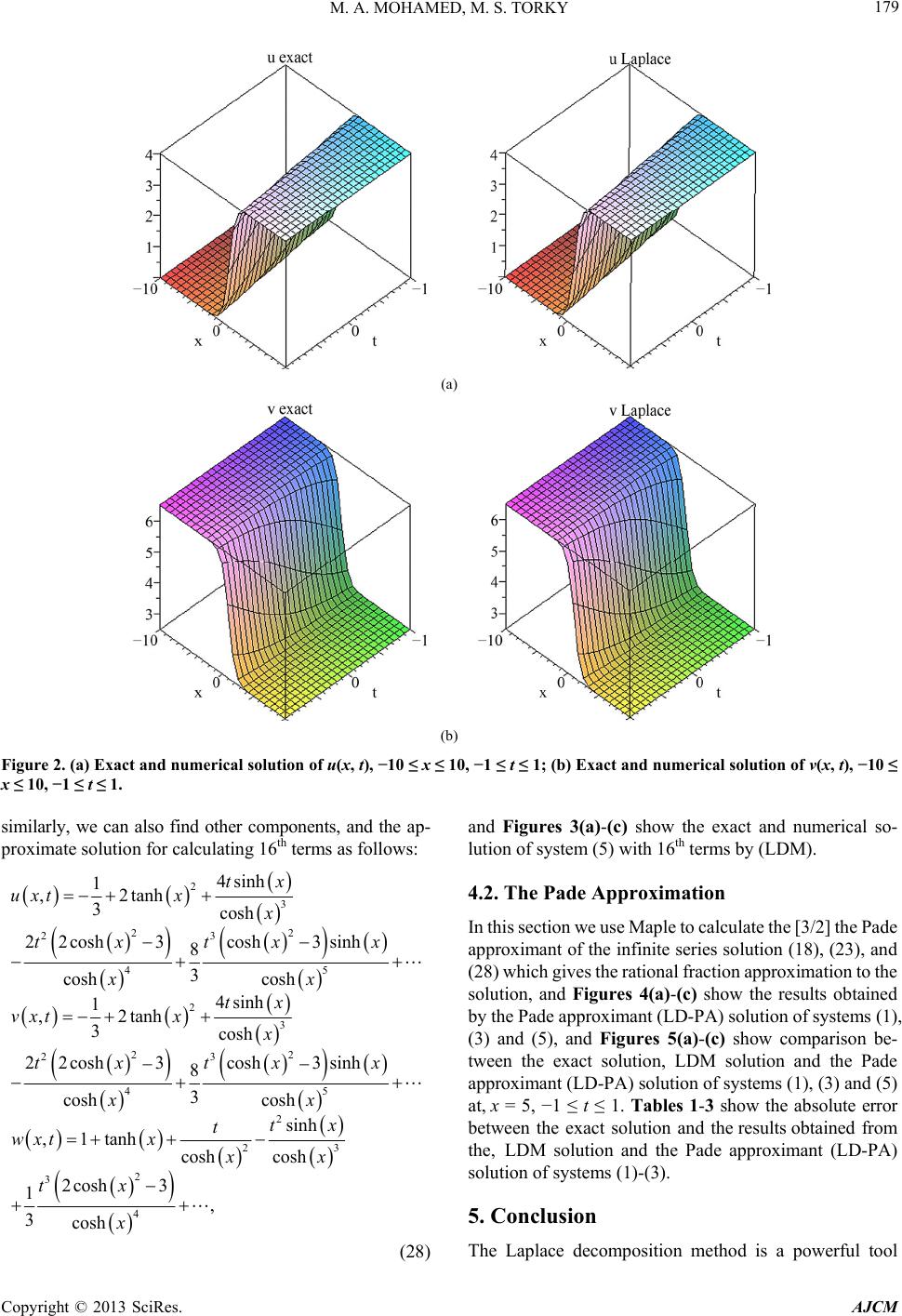 M. A. MOHAMED, M. S. TORKY 179 (a) (b) Figure 2. (a) Exact and numerical solution of u(x, t), −10 ≤ x ≤ 10, −1 ≤ t ≤ 1; (b) Exact and numerical solution of v(x, t), −10 ≤ x ≤ 10, −1 ≤ t ≤ 1. similarly, we can also find other components, and the ap- proximate solution for calculating 16th terms as follows: 2 3 22 23 45 2 3 22 23 45 2 23 2 3 4sinh 1 ,2tanh 3cosh 22cosh 3cosh3sinh 8 3 cosh cosh 4sinh 1 ,2tanh 3cosh 22cosh 3cosh3sinh 8 3 cosh cosh sinh ,1tanh cosh cosh 2cosh 3 1 3co tx uxtx x tx txx xx tx vxtx x tx txx xx tx t wxtx xx tx and Figures 3(a)-(c) show the exact and numerical so- lution of system (5) with 16th terms by (LDM). 4.2. The Pade Approximation 4, sh x (28) In this section we use Maple to calculate the [3/2] the Pade approximant of the infinite series solution (18), (23), and (28) which gives the rational fraction approximation to the solution, and Figures 4(a)-(c) show the results obtained by the Pade approximant (LD-PA) solution of systems (1), (3) and (5), and Figures 5(a)-(c) show comparison be- tween the exact solution, LDM solution and the Pade approximant (LD-PA) solution of systems (1), (3) and (5) at, x = 5, −1 ≤ t ≤ 1. Tables 1-3 show the absolute error between the exact solution and the results obtained from the, LDM solution and the Pade approximant (LD-PA) solution of systems (1)-(3). 5. Conclusion The Laplace decomposition method is a powerful tool Copyright © 2013 SciRes. AJCM 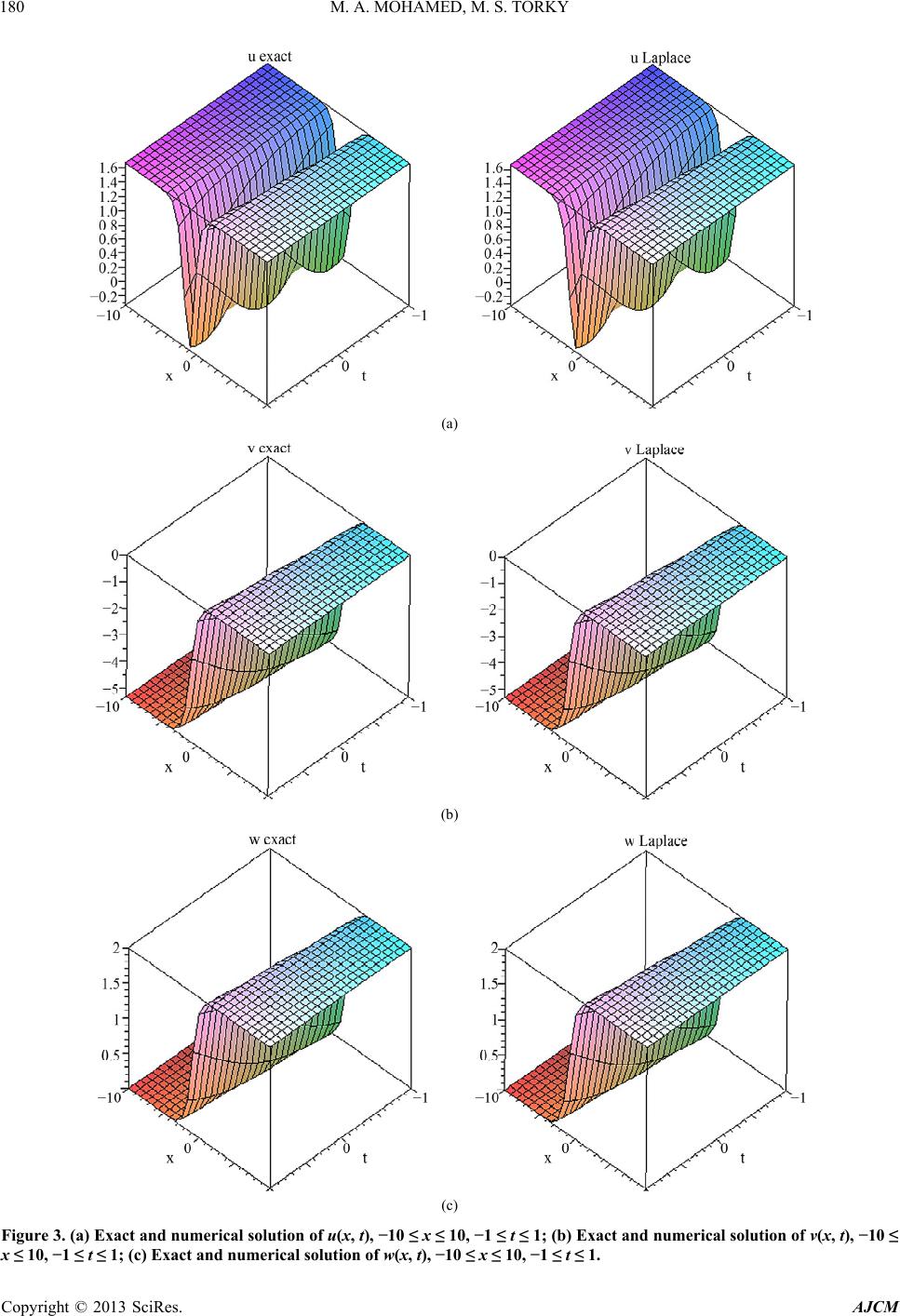 M. A. MOHAMED, M. S. TORKY 180 (a) (b) (c) Figure 3. (a) Exact and numerical solution of u(x, t), −10 ≤ x ≤ 10, −1 ≤ t ≤ 1; (b) Exact and numerical solution of v(x, t), −10 ≤ x ≤ 10, −1 ≤ t ≤ 1; (c) Exact and numerical solution of w(x, t), −10 ≤ x ≤ 10, −1 ≤ t ≤ 1. Copyright © 2013 SciRes. AJCM  M. A. MOHAMED, M. S. TORKY 181 (a) (b) (c) Figure 4. (a) The Pade approximant (LD-PA) solution of u(x, t) and v(x, t) of example 1, −10 ≤ x ≤ 10, −1 ≤ t ≤ 1; (b) The Pade approximant (LD-PA) solution of u(x, t) and v(x, t) of example 2, −10 ≤ x ≤ 10, −1 ≤ t ≤ 1; (c) The Pade approximant (LD-PA) solution of u(x, t) and v(x, t) and w(x, t) of example 3, −10 ≤ x ≤ 10, −1 ≤ t ≤ 1. Copyright © 2013 SciRes. AJCM 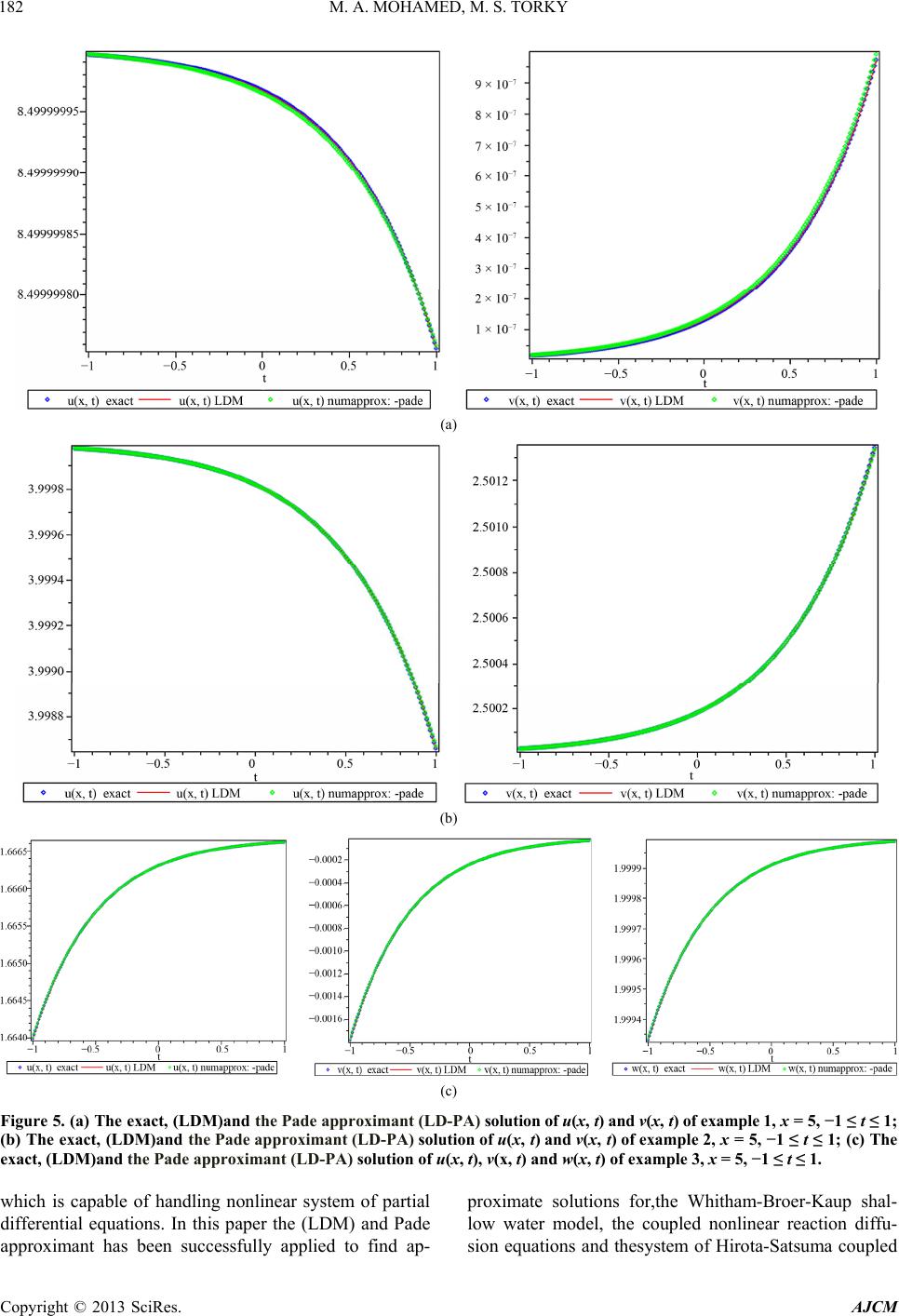 M. A. MOHAMED, M. S. TORKY Copyright © 2013 SciRes. AJCM 182 (a) (b) (c) Figure 5. (a) The exact, (LDM)and the Pade approximant (LD-PA) solution of u(x, t) and v(x, t) of example 1, x = 5, −1 ≤ t ≤ 1; (b) The exact, (LDM)and the Pade approximant (LD-PA) solution of u(x, t) and v(x, t) of example 2, x = 5, −1 ≤ t ≤ 1; (c) The exact, (LDM)and the Pade approximant (LD-PA) solution of u(x, t), v(x, t) and w(x, t) of example 3, x = 5, −1 ≤ t ≤ 1. which is capable of handling nonlinear system of partial differential equations. In this paper the (LDM) and Pade approximant has been successfully applied to find ap- proximate solutions for,the Whitham-Broer-Kaup shal- low water model, the coupled nonlinear reaction diffu- sion equations and thesystem of Hirota-Satsuma coupled 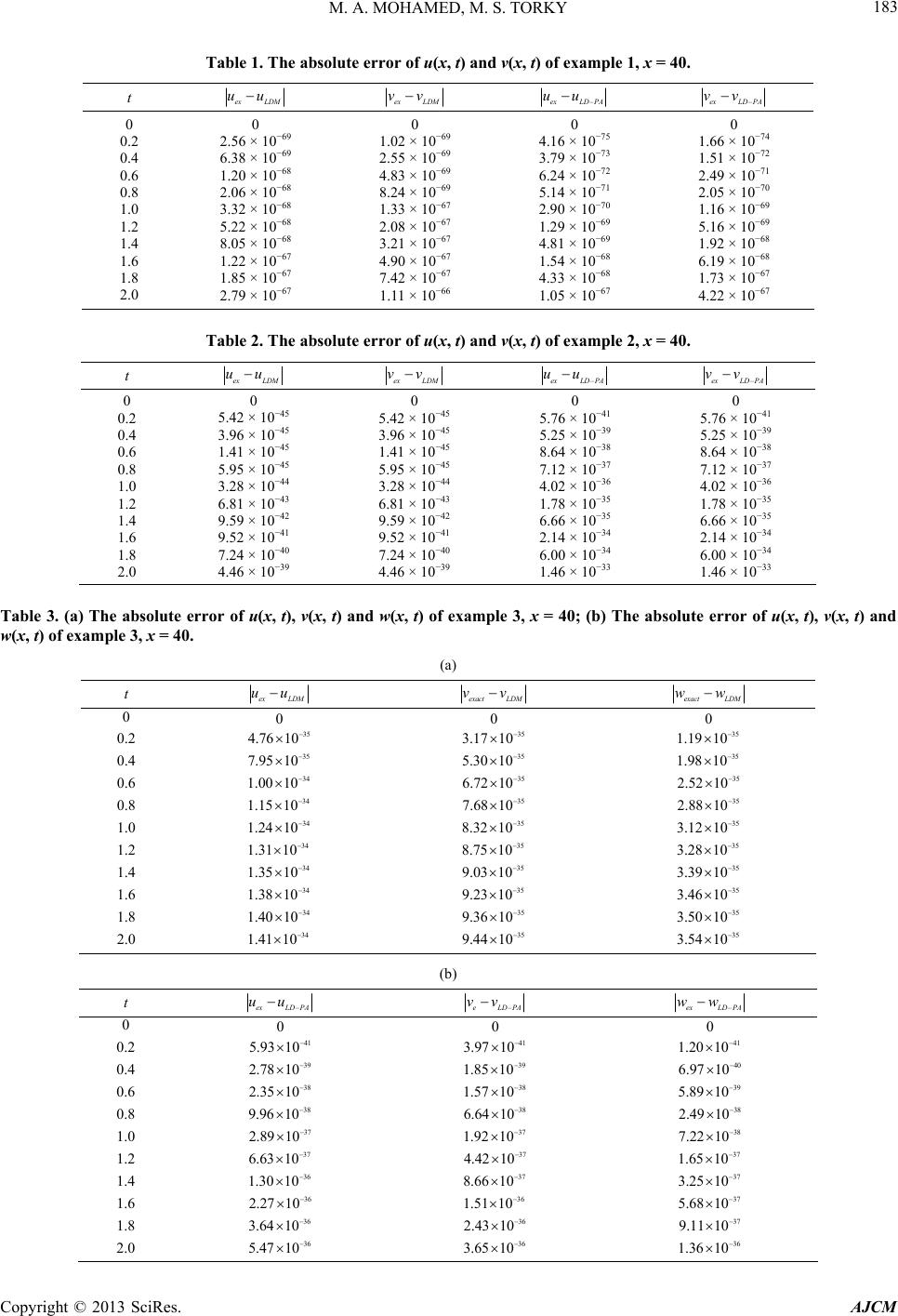 M. A. MOHAMED, M. S. TORKY 183 Table 1. The absolute error of u(x, t) and v(x, t) of example 1, x = 40. t exLDM uu exLDM vv –exLD PA uu –exLD PA vv 0 0.2 0.4 0.6 0.8 1.0 1.2 1.4 1.6 1.8 2.0 0 2.56 × 10−69 6.38 × 10−69 1.20 × 10−68 2.06 × 10−68 3.32 × 10−68 5.22 × 10−68 8.05 × 10−68 1.22 × 10−67 1.85 × 10−67 2.79 × 10−67 0 1.02 × 10−69 2.55 × 10−69 4.83 × 10−69 8.24 × 10−69 1.33 × 10−67 2.08 × 10−67 3.21 × 10−67 4.90 × 10−67 7.42 × 10−67 1.11 × 10−66 0 4.16 × 10−75 3.79 × 10−73 6.24 × 10−72 5.14 × 10−71 2.90 × 10−70 1.29 × 10−69 4.81 × 10−69 1.54 × 10−68 4.33 × 10−68 1.05 × 10−67 0 1.66 × 10−74 1.51 × 10−72 2.49 × 10−71 2.05 × 10−70 1.16 × 10−69 5.16 × 10−69 1.92 × 10−68 6.19 × 10−68 1.73 × 10−67 4.22 × 10−67 Table 2. The absolute error of u(x, t) and v(x, t) of example 2, x = 40. t ex LDM uu ex LDM vv –exLD PA uu –exLD PA vv 0 0.2 0.4 0.6 0.8 1.0 1.2 1.4 1.6 1.8 2.0 0 5.42 × 10−45 3.96 × 10−45 1.41 × 10−45 5.95 × 10−45 3.28 × 10−44 6.81 × 10−43 9.59 × 10−42 9.52 × 10−41 7.24 × 10−40 4.46 × 10−39 0 5.42 × 10−45 3.96 × 10−45 1.41 × 10−45 5.95 × 10−45 3.28 × 10−44 6.81 × 10−43 9.59 × 10−42 9.52 × 10−41 7.24 × 10−40 4.46 × 10−39 0 5.76 × 10−41 5.25 × 10−39 8.64 × 10−38 7.12 × 10−37 4.02 × 10−36 1.78 × 10−35 6.66 × 10−35 2.14 × 10−34 6.00 × 10−34 1.46 × 10−33 0 5.76 × 10−41 5.25 × 10−39 8.64 × 10−38 7.12 × 10−37 4.02 × 10−36 1.78 × 10−35 6.66 × 10−35 2.14 × 10−34 6.00 × 10−34 1.46 × 10−33 Table 3. (a) The absolute error of u(x, t), v(x, t) and w(x, t) of example 3, x = 40; (b) The absolute error of u(x, t), v(x, t) and w(x, t) of example 3, x = 40. (a) t exLDM uu exactLDM vv exactLDM ww 0 0.2 0.4 0.6 0.8 1.0 1.2 1.4 1.6 1.8 2.0 0 35 4.76 10 35 7.95 10 34 1.00 10 34 1.15 10 34 1.24 10 34 1.31 10 34 1.35 10 34 1.38 10 34 1.40 10 34 1.41 10 0 35 3.17 10 35 5.30 10 35 6.72 10 35 7.68 10 35 8.32 10 35 8.75 10 35 9.03 10 35 9.23 10 35 9.36 10 35 9.44 10 0 35 1.19 10 35 1.98 10 35 2.52 10 35 2.88 10 35 3.12 10 35 3.28 10 35 3.39 10 35 3.46 10 35 3.50 10 35 3.54 10 (b) t –exLD PA uu –eLDPA vv –exLD PA ww 0 0.2 0.4 0.6 0.8 1.0 1.2 1.4 1.6 1.8 2.0 0 41 5.93 10 39 2.78 10 38 2.35 10 38 9.96 10 37 2.89 10 37 6.63 10 36 1.30 10 36 2.27 10 36 3.64 10 36 5.47 10 0 41 3.97 10 39 1.85 10 38 1.57 10 38 6.64 10 37 1.92 10 37 4.42 10 37 8.66 10 36 1.51 10 36 2.43 10 36 3.65 10 0 41 1.20 10 40 6.97 10 39 5.89 10 38 2.49 10 38 7.22 10 37 1.65 10 37 3.25 10 37 5.68 10 37 9.11 10 36 1.36 10 Copyright © 2013 SciRes. AJCM  M. A. MOHAMED, M. S. TORKY 184 KdV. It was noted that the scheme found the solutions without any discretization or restrictive assumption, and it was free from round-off errors and therefore reduced the numerical computations to a great extent. REFERENCES [1] S. A. Khuri, “A Laplace Decomposition Algorithm Ap- plied to Class of Nonlinear Differential Equations,” Jour- nal of Applied Mathematics, Vol. 1, No. 4, 2001, pp. 141- 155. [2] H. Hosseinzadeh, H. Jafari and M. Roohani, “Application of Laplace Decomposition Method for Solving Klein- Gordon Equation,” World Applied Sciences Journal, Vol. 8, No. 7, 2010, pp. 809-813. [3] M. Khan, M. Hussain, H. Jafari and Y. Khan, “Applica- tion of Laplace Decomposition Method to Solve Nonlin- ear Coupled Partial Differential Equations,” World Ap- plied Sciences Journal, Vol. 9, No. 1, 2010, pp. 13-19. [4] E. Yusufoglu (Aghadjanov), “Numerical Solution of Duff- ing Equation by the Laplace Decomposition Algorithm,” Applied Mathematics and Computation, Vol. 177, No. 2, 2006, pp. 572-580. doi:10.1016/j.amc.2005.07.072 [5] T. Xu, J. Li and H.-Q. Zhang, “New Extension of the Tanh-Function Method and Application to the Whitham- Broer-Kaup Shallow Water Model with Symbolic Com- putation,” Physics Letters A , Vol. 369, No. 5-6, 2007, pp. 458-463. doi:10.1016/j.physleta.2007.05.047 [6] A. A. Solimana and M. A. Abdoub, “Numerical Solutions of Nonlinear Evolution Equations Using Variational It- eration Method,” Journal of Computational and Applied Mathematics, Vol. 207, No. 1, 2007, pp. 111-120. doi:10.1016/j.cam.2006.07.016 [7] E. Fan, “Soliton Solutions for a Generalized Hirota-Sa- tsuma Coupled KdV Equation and a Coupled MKdV Equation,” Physics Letters A, Vol. 2852, No. 1-2, 2001, pp. 18-22. doi:10.1016/S0375-9601(01)00161-X [8] H. Jafari and V. Daftardar-Gejji, “Solving Linear and Nonlinear Fractional Diffution and Wave Equations by Adomian Decomposition,” Applied Mathematics and Com- putation, Vol. 180, No. 2, 2006, pp. 488-497. doi:10.1016/j.amc.2005.12.031 [9] F. Abdelwahid, “A Mathematical Model of Adomian Polynomials,” Applied Mathematics and Computation, Vol. 141, No. 2-3, 2003, pp. 447-453. doi:10.1016/S0096-3003(02)00266-7 [10] T. A. Abassya, M. A. El-Tawil and H. El-Zoheiry, “Exact Solutions of Some Nonlinear Partial Differential Equa- tions Using the Variational Iteration Method Linked with Laplace Transforms and the Pade Technique,” Computers and Mathematics with Applications, Vol. 54, No. 7-8, 2007, pp. 940-954. doi:10.1016/j.camwa.2006.12.067 Copyright © 2013 SciRes. AJCM
|